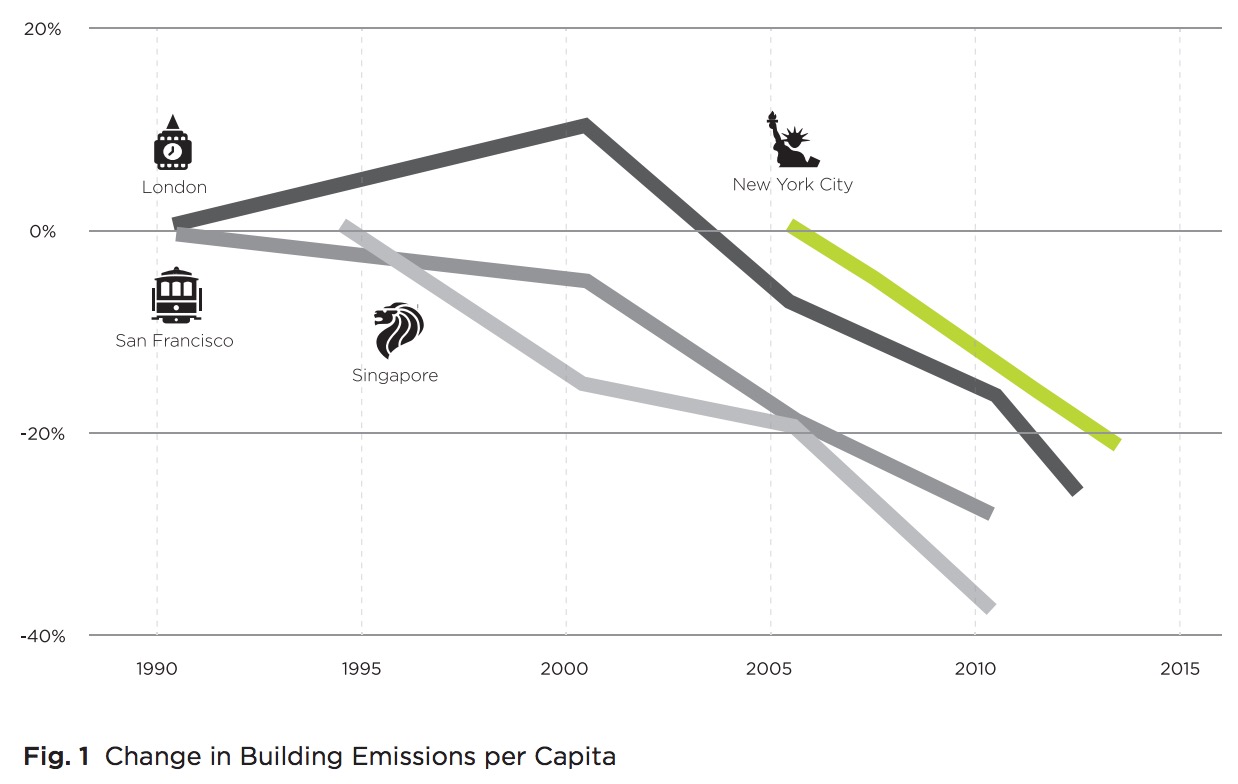URBAN GREEN COUNCIL
Introduction
Frankfurt and other German cities are renowned for their commitment to quality construction and engineering. London is filled with historic and diverse buildings. Singapore is famous for its direct regulation of behavior. Sydney and the rest of Australia attempted to put a price on carbon. San Francisco is a legislative testing ground. What can we learn from these cities? Are there design, policy and construction techniques that make sense in the heat of Singapore or the cold of Frankfurt that can translate to New York’s climate?
New York City is the largest city in the world to mandate carbon reductions of 80% from 2005 levels by 2050. We evaluated energy codes and building industry practice in Frankfurt, London, San Francisco, Singapore, and Sydney to suggest ways to advance New York City’s efforts toward this and other sustainability goals. Key trends among the peer cities show that:
- Energy codes based solely on performance result in building stakeholders making decisions that lead to greater energy efficiency
- Building labeling communicates operational energy consumption and involves the public in efficiency improvements.
- Joint classroom and on-the-job education for construction workers raises the overall quality of building construction.
Overview
All the cities studied in this report established goals to reduce emissions, and some are outpacing New York City. Frankfurt and London have been tracking emissions for decades and were early adopters of carbon reduction goals, which is noteworthy given the time required to see changes in citywide emissions. The United Kingdom signed on to the Kyoto protocol in 1990 and passed its Climate Change Act in 2008. Singapore instituted a government-led building-rating program in 2005 called Green Mark. San Francisco has been tracking its emissions in an inventory since 1990. Frankfurt implemented its building energy code in 1977 along with the rest of Germany, with a performance-based metric added to its code in 2002.
In New York City, designers may choose either a prescriptive or performance path to comply with the energy code. On the prescriptive path, regardless of how well a building performs overall, its walls, windows, and other features Overview Fig. 1 Change in Building Emissions per Capita must comply with strict rules set out in a variety of tables. New York’s performance path is based on a building’s annual energy cost, so the price of fuel influences system decisions. Frankfurt, London, and San Francisco measure emissions or energy per building, tying compliance to the code’s purpose.
If buildings were cars, the approach taken by New York and most American cities would be like regulating vehicle weight and engine size rather than simply mandating overall fuel efficiency.
While New York City has successfully implemented a building energy benchmarking program, other cities, such as London and Frankfurt, have taken this strategy one step further. They require public labels that disclose building performance, making building owners and occupants more accountable for their energy use. In London, the label is tied to minimum performance requirements upon the sale or lease of a property.
The European Union created a standardized system for improving training for construction workers. This federal approach helps spread best practices and integrates workers across various trades and locations. Both trade schools and employers drive workforce education in Frankfurt and London. In this system, both workers and their employers can make the decision to seek additional education. This allows workers to take charge of their own education to open more job opportunities, and it creates a pathway for companies to ensure that future projects have highly skilled workers.
Download full version (PDF): What NYC Can Learn From 5 Peer Cities
About Urban Green Council
urbangreencouncil.org
Urban Green Council is the New York Affiliate of the U.S. Green Building Council (USGBC). Our mission is to advance the sustainability of urban buildings through education, advocacy and research…A non-profit organization established in 2002, Urban Green is funded by contributions from foundations, its members, and corporate sponsors. Our in-house experts and a dedicated network of volunteers are helping to transform the built environment in New York City with models that can be replicated in urban centers nationwide.
Tags: New York City, San Francisco, U.S. Green Building Council, UGC, Urban Green Council, USGBC







 RSS Feed
RSS Feed